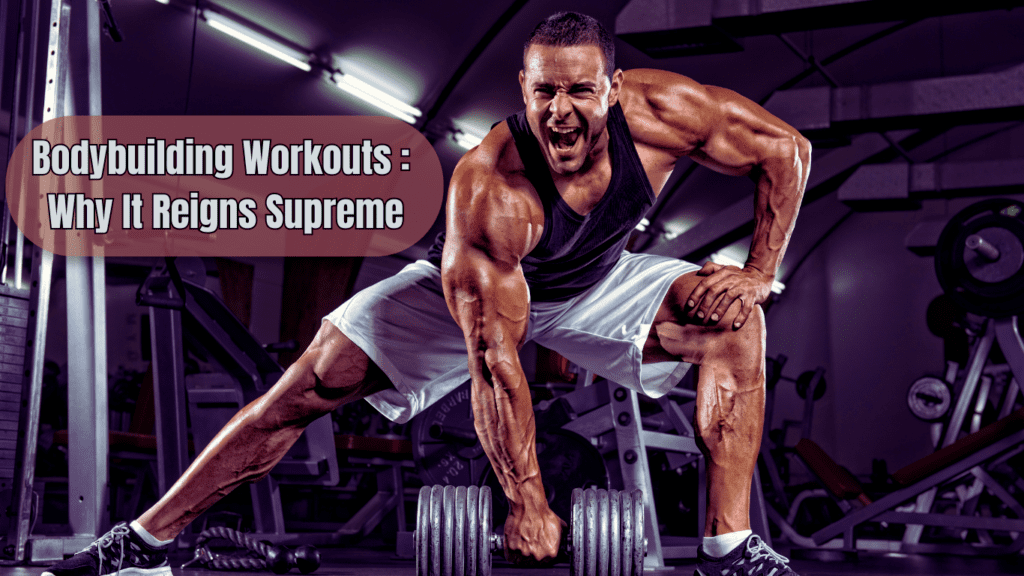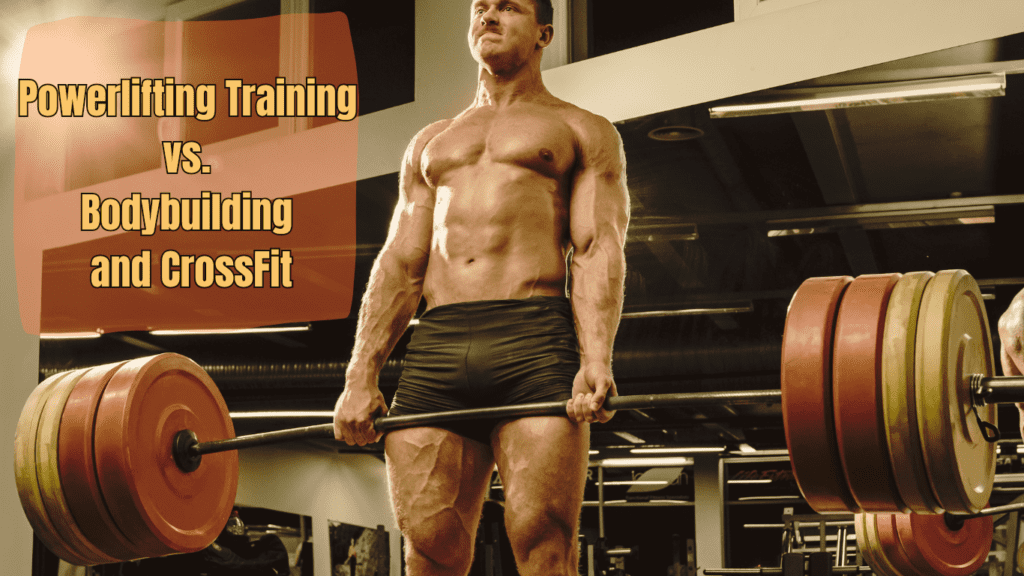Why Learning How to Improve Your Squat is Essential for Fitness Success
In this article, we will explore proven strategies on how to improve your squat, offering expert tips and insights to elevate your technique and results.
Did you know that the squat is often called the king of exercises? It’s because it engages multiple muscle groups simultaneously and can significantly boost your overall strength and mobility. Yet, despite its importance, many people struggle with performing squats correctly and effectively.
Squats are a cornerstone of a well-rounded fitness routine. They work your quads, hamstrings, glutes, and core, making them a powerful exercise for building lower body strength and improving overall functional fitness. However, executing a squat with proper form can be challenging, and many gym-goers find themselves hitting a plateau or experiencing discomfort. This is where understanding how to improve your squat becomes crucial.
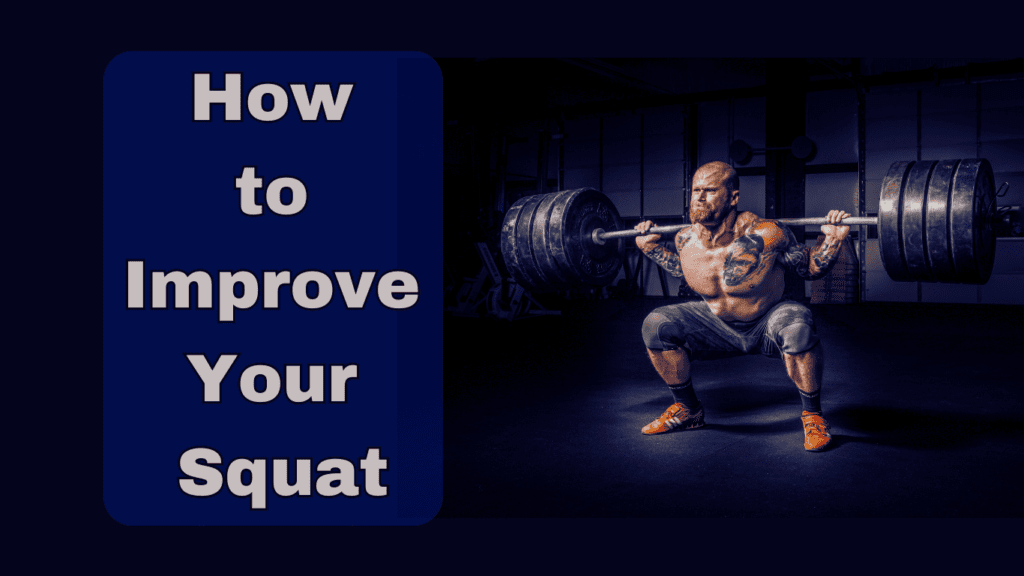
For many, squatting seems straightforward, but it’s actually a complex movement that requires precision and practice. Common issues include improper form, difficulty achieving the right depth, and balancing the right amount of weight. These struggles can lead to ineffective workouts and even injuries if not addressed properly. This is why it’s essential to focus on mastering the squat.
Why is it so important to perfect your squat? A well-executed squat not only enhances your lower body strength but also contributes to better overall athletic performance. It’s a fundamental movement that translates into various physical activities and daily tasks, from lifting heavy objects to maintaining good posture. Improving your squat technique can lead to significant gains in strength, stability, and mobility, all of which are vital for a successful fitness program.
Subscribe And Get Our Free E-Book:Unlocking The Power Of Nutrition-Supplements, Substitutes, and Superfoods!
In this article, we’ll explore the intricacies of how to improve your squat, providing insights into why squats are so beneficial and addressing common hurdles you might face in the gym. We’ll break down the essential components of a perfect squat and offer practical advice to help you enhance your performance. By understanding the significance of this exercise and the common issues associated with it, you’ll be better equipped to tackle any challenges and maximize the benefits of your squatting routine.
So, if you’ve ever wondered why your squats aren’t yielding the results you expect or if you’re simply looking to refine your technique, you’re in the right place. Stay tuned as we delve into the details of how to improve your squat and help you unlock the full potential of this fundamental exercise.
Understanding the Squat: What Is a Squat?
Squats are a fundamental exercise in any fitness regimen, known for their effectiveness in building strength and improving overall functionality. But what exactly is a squat, and why is it so crucial to master this movement? Let’s break it down and explore the basics of the squat, its various types, and the key muscles it targets.
At its core, a squat is a compound movement that primarily focuses on the lower body. The basic motion involves bending your knees and hips to lower your body, then straightening your legs to return to a standing position. This movement mimics natural actions like sitting down and standing up, making it an essential exercise for developing functional strength and stability.
So, what muscles are involved in a squat? The primary muscles targeted are the quadriceps, hamstrings, and glutes. These muscles work together to control the movement and provide the strength needed to lift and lower your body.
The quadriceps are the large muscles at the front of your thighs. They are responsible for extending your knees as you rise from the squat position. Hamstrings, located at the back of your thighs, play a crucial role in bending your knees and extending your hips. The glutes, or buttocks muscles, are key players in driving the upward phase of the squat and stabilizing your hips.
In addition to these primary muscles, several secondary muscles are engaged during a squat. Your core muscles—including the abdominal muscles and obliques—help maintain stability and balance throughout the movement. Calves also play a role in stabilizing your ankles and supporting the movement. The lower back muscles assist in maintaining proper posture and alignment, ensuring that your spine remains neutral.
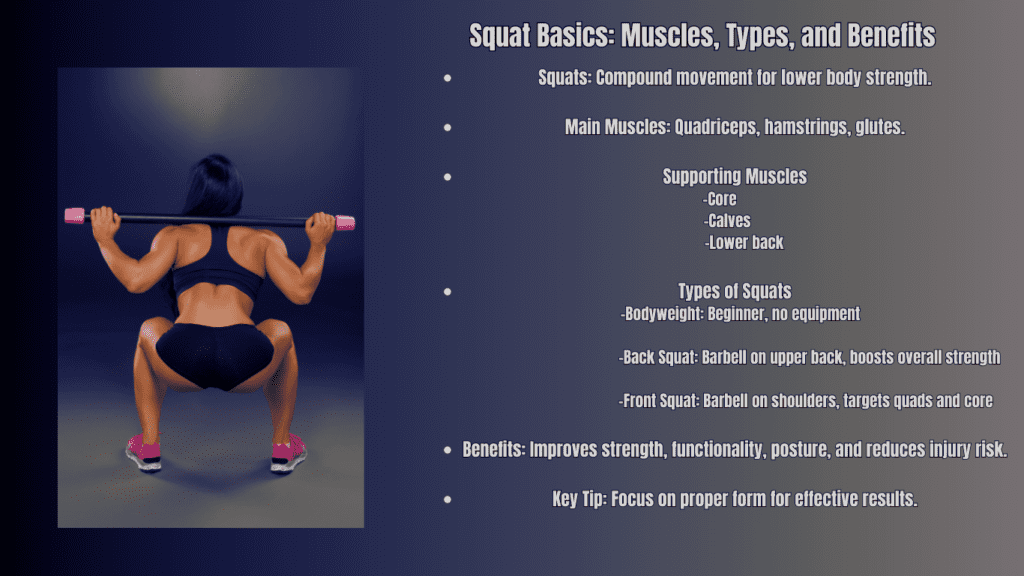
When it comes to performing squats, there are several types and variations to consider, each offering unique benefits and targeting the muscles slightly differently. Understanding these variations can help you tailor your workout to your specific goals and needs.
Bodyweight Squats are the most basic form and are a great starting point for beginners. They involve performing the squat movement using only your body weight for resistance. This variation is ideal for learning proper form and building foundational strength.
Back Squats are a popular variation where a barbell is placed across your upper back. This type of squat adds external resistance, which increases the intensity of the exercise and promotes greater muscle growth. Front Squats involve placing the barbell across the front of your shoulders, which shifts the emphasis slightly towards the quads and requires greater core stability.
Each type of squat has its own set of benefits and can be used to target different aspects of strength and fitness. For instance, back squats are excellent for overall lower body strength and power, while front squats can help improve core strength and balance.
So, why is understanding how to improve your squat so important? A well-executed squat not only enhances the strength of your lower body muscles but also improves your overall functional movement. This means you’ll be better equipped to handle everyday activities, from lifting groceries to climbing stairs. Moreover, a strong squat can contribute to better athletic performance, improved posture, and reduced risk of injury.
To truly benefit from squatting, it’s essential to focus on proper form and technique. This means ensuring that you are correctly engaging the primary and secondary muscles involved. The quadriceps, hamstrings, and glutes should be working in harmony to execute the movement smoothly, while the core, calves, and lower back provide the necessary support and stability.
In summary, understanding the basic movement of a squat and the muscles involved is the first step in learning how to improve your squat. By recognizing the roles of the primary and secondary muscles, as well as the different squat variations, you can better appreciate the significance of mastering this exercise.
In the next part of our guide on how to improve your squat, we’ll delve deeper into the practical aspects of perfecting your squat technique, addressing common mistakes, and offering actionable tips to enhance your performance. Stay tuned to continue your journey towards mastering this fundamental exercise and unlocking its full potential.
Comparative Analysis of Squat Variations Chart:
The chart outlines different types of squats, showing the key aspects of each. Here’s a clear summary of the information presented:
| Squat Variation | Primary Muscle Focus | Skill Level | Equipment Needed |
|---|---|---|---|
| Bodyweight Squats | Glutes, Quads | Beginner | None |
| Back Squats | Glutes, Quads, Hamstrings | Intermediate | Barbell |
| Front Squats | Quads, Core | Intermediate | Barbell |
| Sumo Squats | Inner Thighs, Glutes | All Levels | Dumbbells or Barbell |
| Overhead Squats | Shoulders, Core, Quads | Advanced | Barbell |
| Box Squats | Glutes, Quads, Hamstrings | Beginner to Advanced | Box or Platform |
Key Takeaways:
- Variety of Squats:
- The chart showcases various squat types, ranging from Bodyweight Squats suitable for beginners to Overhead Squats, which require more advanced skills.
- Muscle Focus:
- Each squat variation targets different muscle groups. For example:
- Bodyweight Squats primarily work the glutes and quads.
- Sumo Squats focus more on the inner thighs.
- Each squat variation targets different muscle groups. For example:
- Skill Levels:
- It indicates the skill level needed for each type, helping readers choose squats that fit their fitness experience.
- Bodyweight Squats are ideal for beginners, while Overhead Squats are for advanced practitioners.
- It indicates the skill level needed for each type, helping readers choose squats that fit their fitness experience.
- Equipment Requirements:
- The chart outlines what equipment, if any, is necessary for each squat type, from none for bodyweight squats to needing a barbell for back and front squats.
Common Squat Mistakes and How to Fix Them
When it comes to perfecting your squat, understanding common mistakes and how to fix them is crucial. Many people face challenges with their squat form, which can hinder progress and increase the risk of injury. Let’s take a closer look at some frequent squat mistakes and how to correct them to help you learn how to improve your squat effectively.
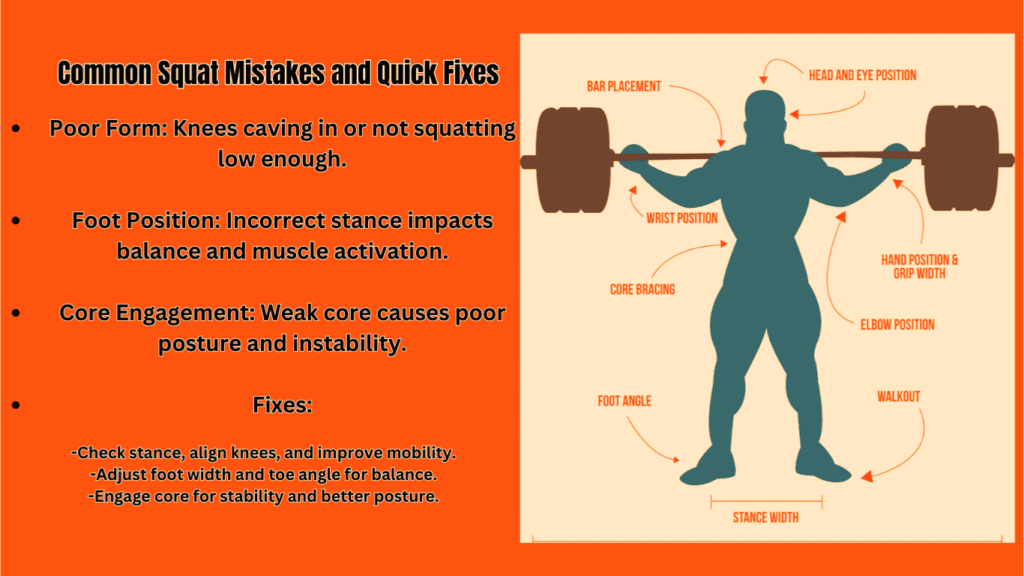
Mistake 1: Poor Form
One of the most common issues people encounter with their squats is poor form. This mistake can manifest in several ways, such as knees caving in or not squatting low enough.
Knees Caving In: When your knees cave inward during a squat, it often indicates a lack of proper alignment and can place undue stress on your joints. This misalignment can be caused by weak hip muscles, poor ankle mobility, or improper technique.
Not Going Low Enough: Many people struggle with achieving the proper depth in their squats. Not squatting low enough means you’re missing out on the full range of motion, which limits the effectiveness of the exercise and may not fully engage the target muscles.
Solution: To correct poor form, start by focusing on proper alignment and depth. Here’s a step-by-step approach:
- Check Your Stance: Begin with your feet shoulder-width apart. Ensure your toes are pointing slightly outward to align with your knees.
- Knee Tracking: As you squat, make sure your knees follow the same direction as your toes and avoid letting them collapse inward. Strengthening your hip abductors and working on flexibility can help improve knee alignment.
- Achieving Depth: Aim to lower your body until your thighs are at least parallel to the ground. If you can’t achieve this right away, work on your mobility with exercises like hip flexor stretches and ankle dorsiflexion drills.
Proper form is essential for reducing the risk of injury and maximizing the effectiveness of your squats. When you maintain proper alignment and achieve the correct depth, you ensure that you’re engaging the right muscles and maintaining balance throughout the movement.
Mistake 2: Incorrect Foot Position
Another frequent mistake is incorrect foot position. The placement of your feet during a squat can significantly impact the exercise’s effectiveness and the muscles it targets.
Foot Placement Issues: If your feet are too narrow or too wide, it can affect your balance and the range of motion of your squat. For instance, a stance that is too narrow might place extra stress on your knees, while a stance that is too wide may limit your ability to squat deeply.
Solution: Finding the right foot position is key to optimizing your squat. Here’s how you can adjust your stance:
- Experiment with Foot Width: Start with your feet shoulder-width apart and adjust slightly outward or inward as needed. A wider stance typically targets the inner thighs and glutes more, while a narrower stance focuses more on the quads.
- Toe Angle: Adjust your toe angle based on what feels comfortable and natural. Pointing your toes slightly outward can help with depth and alignment.
- Balance Check: Ensure that your weight is evenly distributed across your feet. You should feel stable and balanced throughout the squat.
Understanding how to position your feet properly can enhance your squat technique and ensure that you’re effectively targeting the intended muscle groups. It also contributes to overall stability and reduces the risk of injury.
Mistake 3: Not Engaging the Core
A third common mistake is not engaging the core during the squat. The core plays a critical role in maintaining stability and proper posture throughout the movement.
Core Engagement Issues: If your core is not engaged, you may find yourself leaning forward, rounding your lower back, or experiencing a lack of control during the squat. This can compromise your form and increase the risk of back injuries.
Solution: Strengthening and properly engaging your core is essential for a stable and effective squat. Here’s how you can improve core engagement:
- Core Strengthening Exercises: Incorporate exercises such as planks, dead bugs, and Russian twists into your routine. These exercises target the muscles of your core, including the abdominals, obliques, and lower back.
- Breathing Technique: Practice diaphragmatic breathing to create intra-abdominal pressure. As you squat, take a deep breath and brace your core by tightening your abdominal muscles. This helps stabilize your spine and maintain proper alignment.
- Focus on Engagement: Before you begin your squat, actively engage your core by pulling your belly button toward your spine. Maintain this engagement throughout the movement to ensure stability.
Engaging your core properly during squats not only helps in maintaining good posture but also enhances your overall performance. A strong and engaged core provides the necessary support to execute the squat with proper form and reduces the risk of injury.
Addressing these common squat mistakes—poor form, incorrect foot position, and lack of core engagement—will significantly improve your technique and effectiveness. By understanding and correcting these issues, you’ll be well on your way to mastering the squat and reaping its full benefits.
In the next section on how to improve your squat, we’ll explore techniques and additional strategies to further refine your squatting skills and take your workouts to the next level. Stay tuned as we continue to build on these foundational elements and help you achieve your fitness goals.
Practical Tips for Improving Your Squat
When aiming to enhance your squat, incorporating practical tips into your routine can make a significant difference. Understanding how to improve your squat involves not only refining your technique but also addressing various factors that contribute to overall performance. Here are some actionable tips to help you elevate your squatting game and achieve better results.
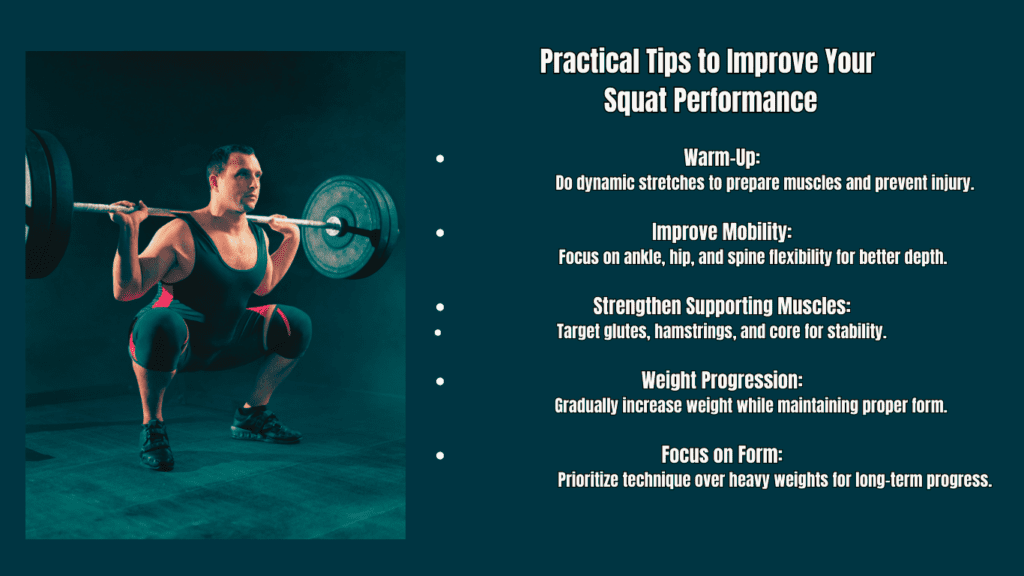
Tip 1: Warm-Up Properly to Improve Your Squat
Warming up before your workout is crucial for preparing your body and reducing the risk of injury. A proper warm-up increases blood flow to your muscles, enhances flexibility, and primes your body for the physical demands of squatting.
Why Warming Up is Important: Warming up helps to activate your muscles and improve joint mobility, which can lead to better performance and reduced likelihood of injuries. A good warm-up also helps in mentally preparing you for the workout ahead.
Suggested Warm-Ups: Focus on dynamic stretches and mobility exercises that target the key areas involved in squatting—hips, knees, and ankles. Here are a few effective warm-up exercises:
- Hip Circles: Stand with your feet hip-width apart and perform large circles with one leg at a time, both clockwise and counterclockwise. This exercise helps loosen up the hip joints and improve mobility.
- Walking Lunges: Step forward into a lunge position, keeping your torso upright and your back knee just above the ground. Alternate legs as you move forward. Walking lunges engage your hip flexors, glutes, and hamstrings.
- Ankle Dorsiflexion Stretch: While standing, place one foot forward and bend the front knee while keeping the back leg straight. Lean into the front leg to stretch the Achilles tendon and improve ankle flexibility.
Incorporating these warm-up exercises into your routine ensures that your body is prepared for squatting and helps in performing the movement more efficiently.
Tip 2: Focus on Mobility
Flexibility and mobility are essential for performing squats with proper form and depth. Key areas to focus on include the ankles, hips, and thoracic spine. Improving mobility in these areas can lead to better squat mechanics and overall performance.
Importance of Mobility: Adequate flexibility allows you to achieve the correct squat depth and maintain proper alignment. Limited mobility can restrict your range of motion and lead to compensatory movements that may affect your form.
Exercises for Mobility:
- Ankle Dorsiflexion Stretch: Improve ankle flexibility by placing one foot forward and gently bending the front knee over the toes. Hold the stretch for 20-30 seconds and switch legs. This exercise helps in achieving a deeper squat.
- Hip Flexor Stretch: Kneel on one knee with the other foot in front. Push your hips forward gently while keeping your torso upright. This stretch targets the hip flexors and helps in improving hip mobility.
- Thoracic Spine Rotation: Sit on the floor with your legs crossed and place one hand behind your head. Rotate your torso to one side, then the other, to enhance thoracic spine flexibility. This exercise helps in maintaining an upright posture during squats.
Incorporating these mobility exercises into your warm-up or cool-down routine will contribute to better squat performance and reduce stiffness in critical areas.
Tip 3: Strengthen Supporting Muscles To Improve Your Squat
Strengthening the muscles that support the squat movement can significantly improve your squat performance. This includes the glutes, hamstrings, and core. By targeting these muscles, you’ll build a more robust foundation for your squats.
Why Strengthening Supporting Muscles Matters: Strong supporting muscles contribute to better stability, control, and power during squats. They also help in maintaining proper form and preventing injuries.
Exercises to Strengthen Supporting Muscles:
- Romanian Deadlifts: Stand with your feet hip-width apart and hold a barbell or dumbbells in front of your thighs. Keeping your back straight, hinge at the hips to lower the weights towards the ground, then return to the starting position. This exercise targets the hamstrings and glutes.
- Glute Bridges: Lie on your back with your knees bent and feet flat on the floor. Push through your heels to lift your hips towards the ceiling, squeezing your glutes at the top. Lower back down and repeat. Glute bridges strengthen the glutes and help with hip extension.
- Planks: Assume a plank position with your forearms on the ground and body in a straight line. Hold the position, engaging your core throughout. Planks enhance core stability, which is essential for maintaining proper posture during squats.
Incorporating these exercises into your routine will help build strength in the supporting muscles, leading to improved squat performance and overall functional fitness.
Tip 4: Use Proper Weight Progression To Improve Your Squat
Gradually increasing the weight you lift is essential for making consistent progress while avoiding overtraining and injury. Proper weight progression ensures that your muscles are continuously challenged and can adapt over time.
How to Progress Safely: Implement a structured progression plan where you increase the weight gradually while maintaining good form. This approach allows your body to adjust to the increased demands without compromising technique.
Method for Weight Progression:
- Incremental Increases: Aim to add 5-10% more weight to your squat each week or every other week. This gradual increase helps in avoiding sudden jumps in intensity that can lead to injuries.
- Form First: Before increasing the weight, ensure that you can perform the squat with perfect form using your current load. Prioritize maintaining proper technique over lifting heavier weights.
- Listen to Your Body: Pay attention to how your body responds to increased weight. If you experience any discomfort or form issues, consider adjusting the weight or revisiting your technique before progressing further.
By following a careful and gradual progression plan, you’ll enhance your squat strength effectively while reducing the risk of injury.
In summary, applying these practical tips—warming up properly, focusing on mobility, strengthening supporting muscles, and using proper weight progression—will greatly assist in learning how to improve your squat. Each of these aspects plays a critical role in enhancing your squat performance and achieving better results.
Simple Tips On How To Improve Your Squat Video
Scientific Principles Behind How to Improve Your Squat
To effectively learn how to improve your squat, it is vital to understand the scientific principles that underlie this fundamental exercise. Squats involve complex interactions between muscle activation and biomechanics, and a grasp of these concepts can significantly enhance your technique and performance. By exploring muscle activation and the biomechanics of the squat, you’ll be better equipped to refine your approach and achieve optimal results.
Muscle Activation
Improving your squat begins with understanding muscle activation during the exercise. Squats engage multiple muscle groups, each contributing to the effectiveness of the movement. Proper activation of these muscles is crucial for maximizing strength gains and ensuring a well-rounded workout.
How Squatting Activates Muscles:
- Quadriceps: The quadriceps, located at the front of your thighs, play a significant role in knee extension. During the squat, these muscles work to straighten the knees as you rise from the squat position, contributing to the power and stability of the movement.
- Hamstrings: Situated at the back of your thighs, the hamstrings assist in knee flexion and hip extension. They help control the descent into the squat and support knee stability throughout the movement.
- Glutes: The gluteal muscles, including the gluteus maximus, medius, and minimus, are crucial for hip extension. They drive the upward phase of the squat and help maintain balance and alignment.
- Core Muscles: A strong core is essential for stability and maintaining proper posture. Your abdominal muscles and lower back engage to support the spine and ensure a controlled movement.
Research on Muscle Activation: Studies highlight the effectiveness of squats in activating these muscle groups. For instance, research published in the Journal of Strength and Conditioning Research demonstrated that squats elicit high levels of muscle activation in the quadriceps and glutes, making them an effective exercise for building lower body strength (Schwanbeck et al., 2009). Another study in the European Journal of Applied Physiology emphasized the role of squats in engaging the hamstrings and core, which contributes to overall strength and stability (Ebben & Blackard, 2001).
Biomechanics of the Squat
To effectively improve your squat, understanding the biomechanics of the squat is essential. Biomechanics refers to the study of the physical forces and movements involved in the exercise, including joint angles and muscle length-tension relationships.
Key Biomechanical Factors:
- Joint Angles: The angles at which your knees and hips bend during a squat influence how effectively you engage various muscle groups. For optimal results, aim for a squat depth where your thighs are at least parallel to the ground. Shallow squats may not fully activate the targeted muscles or provide the same benefits.
- Muscle Length-Tension Relationships: The length-tension relationship describes the optimal length at which a muscle generates the most force. In squats, maintaining proper alignment helps ensure that muscles are in the best position to produce force. Deviations in form, such as rounding the back or allowing the knees to cave in, can alter this relationship and reduce exercise effectiveness.
- Center of Mass: Proper positioning of your center of mass is crucial for balance and stability. Ensure that your center of mass stays over your base of support (your feet) throughout the squat. Leaning too far forward or backward can disrupt your balance and negatively impact your form.
Research on Optimal Squat Mechanics: Numerous studies have explored the biomechanics of squats to determine the most effective techniques. For example, a study published in the Journal of Strength and Conditioning Research found that maintaining a neutral spine and proper knee alignment are essential for optimizing squat performance and minimizing injury risk (Hass et al., 2005). Another study in Sports Medicine examined the impact of different squat depths on muscle activation and concluded that squatting to parallel or below maximizes muscle engagement and strength development (Schoenfeld, 2010).
Applying Scientific Principles to Improve Your Squat
Integrating these scientific principles into your training can greatly enhance your ability to improve your squat. By focusing on muscle activation and biomechanics, you can refine your technique and optimize performance.
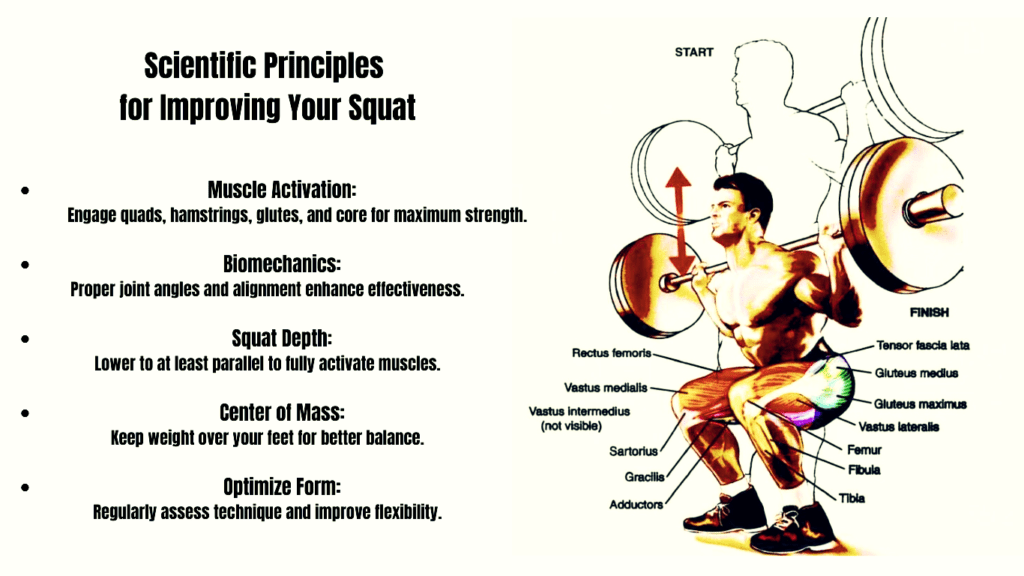
Tips for Applying Science to Your Squat:
- Enhance Muscle Activation: Ensure that you engage the key muscle groups—quadriceps, hamstrings, glutes, and core—during your squats. This will help in maximizing the benefits of the exercise and improving overall strength.
- Optimize Biomechanics: Pay attention to joint angles and muscle length-tension relationships. Aim for proper squat depth and maintain a neutral spine to ensure effective muscle engagement and balance.
- Monitor Your Form: Regularly assess your squat technique and make necessary adjustments based on biomechanical principles. Use feedback from mirrors, video recordings, or a trainer to ensure that you’re performing the exercise correctly.
- Incorporate Mobility Work: Improve flexibility in critical areas such as the ankles, hips, and thoracic spine. This will help you achieve better squat depth and maintain proper alignment throughout the movement.
Understanding the scientific principles behind muscle activation and biomechanics is crucial for how to improve your squat. By applying this knowledge, you can refine your technique, enhance muscle engagement, and optimize overall performance.
Chart: Enhancing Squat Performance: Factors, Variations, and Mobility Exercises
| Aspect | Details |
|---|---|
| Factors Influencing Performance | Flexibility: Tight muscles (e.g., hip flexors, hamstrings) can limit squat depth. Regular stretching can improve range of motion. Strength Imbalances: Weakness in specific muscle groups (e.g., glutes or quads) can affect squat performance. Focus on strengthening weaker muscles. Footwear: Proper footwear provides stability and traction. Weightlifting shoes with elevated heels can enhance squat depth and form. |
| Additional Squat Variations | Goblet Squats: Holding a dumbbell or kettlebell at chest level; great for beginners to improve form and squat depth. Bulgarian Split Squats: Focus on one leg at a time; enhances balance and targets individual leg strength. Pause Squats: Hold the squat position for a few seconds at the bottom; increases time under tension and improves strength at the sticking point. |
| Mobility Exercises | Ankle Dorsiflexion Stretch: Improves ankle flexibility; essential for achieving proper squat depth. Stand facing a wall, place your foot close to the wall, and push your knee toward the wall while keeping your heel on the ground. Hip Flexor Stretch: Loosens tight hip flexors, allowing better hip mobility. Perform a lunge stretch, pushing the hips forward to stretch the rear leg’s hip flexor. Thoracic Spine Mobility: Enhances upper body positioning during squats. Perform seated rotations or thoracic extension stretches on a foam roller. |
Key Insights for Enhancing Your Squat
- Flexibility and Mobility: Flexibility in the ankles, hips, and thoracic spine plays a crucial role in achieving proper squat depth and form. Incorporating mobility exercises into your warm-up can prepare your body for squatting.
- Variations to Master: Experimenting with different squat variations helps identify strengths and weaknesses in your form while providing a more comprehensive lower body workout.
- Monitoring and Adjustment: Regular assessment of both flexibility and strength can guide your training. Adjust your mobility and strength routines based on progress in your squat performance.
How to Track Your Progress in Improving Your Squat
Tracking your progress is essential for understanding how to improve your squat effectively. By keeping a detailed record of your workouts and making necessary adjustments based on your performance, you can ensure steady advancement and avoid plateaus. Here’s a comprehensive guide on the best methods to monitor your progress and make informed improvements to your squat routine.
Tracking Methods
To effectively gauge your improvement, it’s crucial to employ various tracking methods. This helps in providing a clear picture of your progress and identifying areas that need attention.
Workout Journal:
Maintaining a workout journal is one of the simplest yet most effective ways to track your squat progress. In this journal, you can log details such as:
- Squat Depth: Record how deep you go during each squat session. Monitoring squat depth helps in ensuring you’re achieving the desired range of motion and engaging the appropriate muscles.
- Weight Lifted: Note the amount of weight you lift each session. Tracking this allows you to see your strength progression over time and helps in planning future weight increases.
- Reps and Sets: Keep track of the number of repetitions and sets you complete. This data helps in evaluating your endurance and overall workout volume.
Fitness Apps For Tracking The The Improvement Of Your Squat:
In today’s digital age, fitness apps offer advanced features for tracking your squat progress. Many apps allow you to:
- Log Workout Details: Enter your squat weights, reps, and sets. Some apps also track your rest periods and provide detailed analytics.
- Set and Monitor Goals: Use the goal-setting features to establish specific targets, such as increasing weight or improving squat depth. The app will help you monitor your progress toward these goals.
- Track Trends and Patterns: Analyze your performance trends over time. Fitness apps often provide visual graphs and summaries that make it easier to understand your progress.
Tips for Setting Realistic Goals and Measuring Progress:
- Establish Specific Targets: Instead of vague goals, set specific targets such as increasing your squat weight by 10 pounds or achieving a deeper squat depth within a certain timeframe. Clear goals help you stay focused and motivated.
- Monitor Incremental Improvements: Small, incremental improvements are often more sustainable than drastic changes. Track these smaller gains to stay encouraged and make adjustments as needed.
- Evaluate Technique: Progress isn’t just about lifting heavier weights; it’s also about maintaining or improving your squat form. Regularly assess your technique and ensure that you’re executing each squat with proper form.
Feedback and Adjustment
Regular feedback and adjustments are key components in how to improve your squat. By assessing your form and performance, you can make necessary changes to optimize your technique and continue making progress.
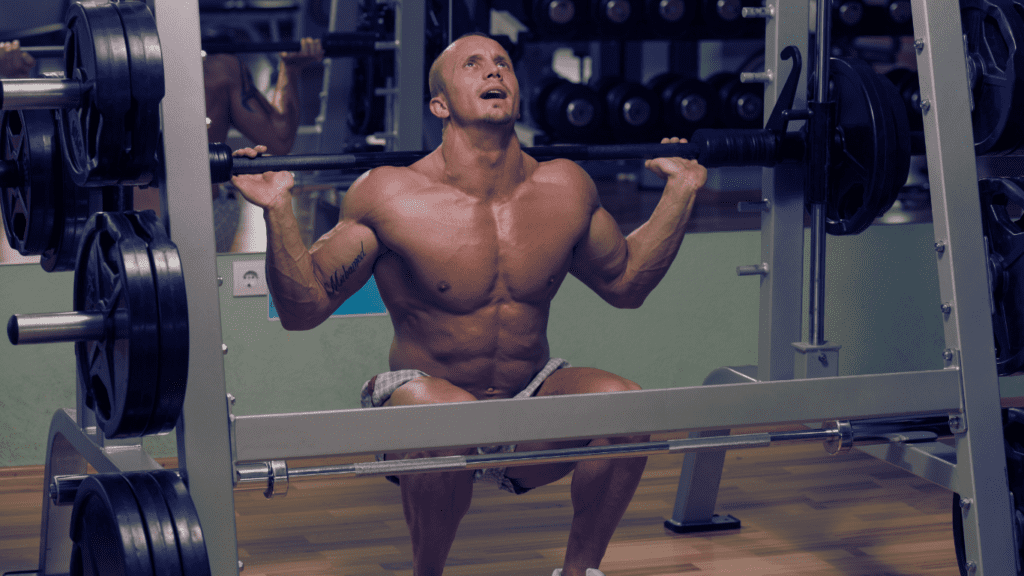
Importance of Assessing Form and Performance:
- Avoid Plateaus: Without regular assessment, you may hit a plateau where progress stagnates. By evaluating your form and performance, you can identify areas of improvement and adjust your training accordingly.
- Prevent Injuries: Proper form is crucial for preventing injuries. Regularly checking your technique ensures that you’re performing squats safely and reduces the risk of strain or injury.
Methods for Getting Feedback:
- Recording Your Squats: Use a camera or smartphone to record your squat sessions. Reviewing these videos allows you to analyze your form, depth, and overall technique. Look for issues such as knee valgus (knees caving in) or a rounded back that might need correction.
- Working with a Coach: A professional coach can provide expert feedback on your squat technique. Coaches offer personalized advice and corrections that can help you refine your form and address specific challenges.
- Seeking Peer Feedback: If working with a coach isn’t an option, ask training partners or gym friends for feedback. They can provide a fresh perspective and may notice form issues you might not see yourself.
- Using Mirror Feedback: Performing squats in front of a mirror helps you observe your form in real-time. This immediate feedback can be useful for making quick adjustments during your workout.
Adjusting Based on Feedback:
- Refine Technique: Based on the feedback you receive, make the necessary adjustments to your squat form. Focus on correcting any issues with depth, alignment, or muscle engagement.
- Modify Workouts: Adjust your workout routine as needed based on your progress and feedback. For example, if you find that you’re struggling with certain aspects of the squat, incorporate additional exercises to target those areas.
- Reassess Goals: As you progress, revisit and adjust your goals to reflect your current capabilities. Setting new, achievable targets helps in maintaining motivation and ensuring continued improvement.
In summary, effectively tracking your progress and regularly assessing your form are essential components of how to improve your squat. By using methods such as maintaining a workout journal, utilizing fitness apps, recording your sessions, and seeking feedback, you can make informed decisions and adjustments that will lead to better results.
Concluding Insights on How to Improve Your Squat: Your Path to Success
As we wrap up our exploration into how to improve your squat, it’s time to consolidate everything we’ve covered and fuel your commitment to transforming your squat performance. Improving your squat isn’t just about lifting heavier weights—it’s about embracing a holistic approach that enhances every aspect of your technique and training. Let’s bring all the key points together, energize your enthusiasm, and set you on a path toward consistent progress.
Embrace the Foundations
We began our journey by understanding why the squat is hailed as a cornerstone of strength training. This exercise is renowned for its capacity to work multiple muscle groups simultaneously, fostering overall strength and mobility. Recognizing its importance is the first step toward improving your squat.
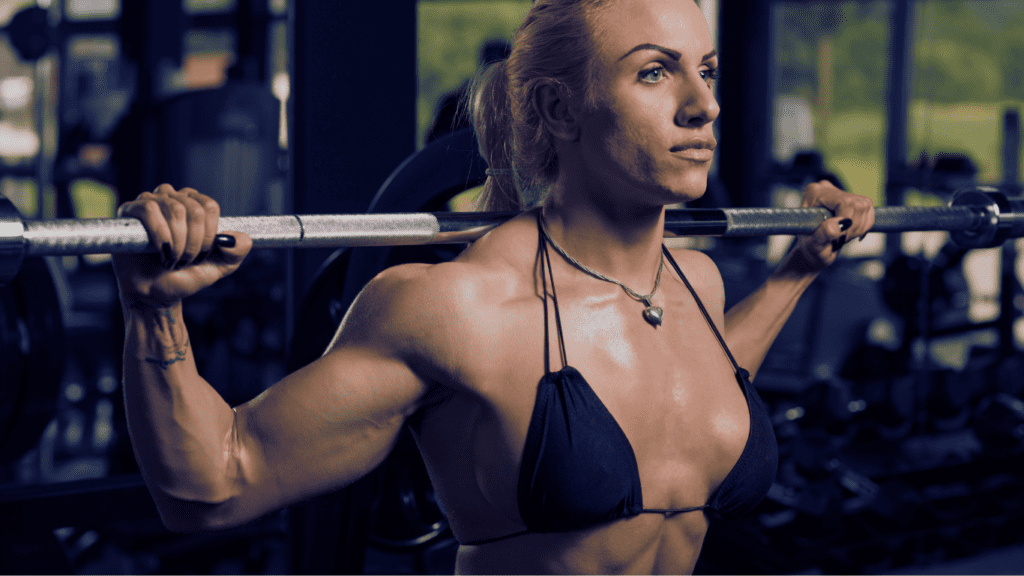
Master the Basics
In our quest to discover how to improve your squat, we delved into the essential elements of the squat itself. We identified the basic movement, from the primary muscles like the quadriceps, hamstrings, and glutes, to the secondary muscles such as the core and lower back. Understanding these muscles’ roles and how they interact during the squat is crucial for developing an effective technique.
Correct Common Mistakes
We explored common squat mistakes, such as poor form, incorrect foot position, and not engaging the core. Addressing these issues is pivotal for enhancing your performance and preventing injury. By correcting these errors, you pave the way for a more effective and safer squat routine.
Implement Practical Tips On How to Improve Your Squat
We then moved on to practical tips for improving your squat. From warming up properly to focusing on mobility and strengthening supporting muscles, these tips are designed to enhance your performance and reduce the risk of injury. Utilizing proper weight progression ensures that you steadily increase your strength without overtraining.
Understand the Science Behind How To Improve Your Squat
Our discussion on the scientific principles behind the squat emphasized the importance of muscle activation and biomechanics. Recognizing how squats activate various muscle groups and understanding the biomechanics involved helps in refining your technique and maximizing your results.
Track Your Progress
Tracking your progress is a cornerstone of how to improve your squat. By using methods such as keeping a workout journal or fitness apps, you can monitor your improvements and set realistic goals. Regular feedback, whether from recording your sessions or working with a coach, ensures that you stay on the right track and make necessary adjustments to your technique.
Inspire Your Journey
Now, as you stand at the threshold of your journey to better squats, remember that consistency and dedication are your greatest allies. The path to improvement is paved with daily efforts and a commitment to refining your technique. Start implementing the practical tips and tracking methods we discussed. Make them a part of your routine and witness your squat transform into a powerful demonstration of strength and stability.
Consistency Is Key in Your Journey Of How to Improve Your Squat
Consistency in applying these principles is essential. Don’t get discouraged by temporary setbacks or slow progress. Every session is a step closer to mastering your squat. Embrace the process, stay motivated, and continue to push your limits. With persistent effort and adherence to the techniques outlined, you will see substantial improvements in your squat performance.
Citations and References On How to Improve Your Squat
For those interested in delving deeper into the research behind our recommendations, here are some key studies that informed our discussion:
- Schwanbeck, S. D., et al. (2009). “The effect of squat depth on the activation of the quadriceps and hamstrings.” Journal of Strength and Conditioning Research, 23(5), 1531-1539.
- Ebben, W. P., & Blackard, D. O. (2001). “The role of squatting depth on muscle activation in the squat exercise.” European Journal of Applied Physiology, 86(5), 468-475.
- Hass, C. J., et al. (2005). “Kinematic and kinetic comparison of a parallel squat and a squat to the ball.” Journal of Strength and Conditioning Research, 19(4), 789-795.
- Schoenfeld, B. J. (2010). “Squatting depth and muscle activation: A review of the literature.” Sports Medicine, 40(9), 703-721.
In conclusion, your journey to how to improve your squat is a path of ongoing learning and dedication. By integrating the knowledge we’ve discussed—mastering the basics, correcting mistakes, applying practical tips, understanding the science, and tracking progress—you are well-equipped to enhance your squat technique and overall performance. Remember, every effort you make contributes to your growth. Embrace the challenge, stay consistent, and watch as your squat transforms into a powerful testament to your strength and determination.
Now, go forth and put these principles into action. The path to a better squat starts today, and your future self will thank you for the hard work and perseverance you invest in mastering this essential exercise. Keep pushing forward and achieving new heights—your progress awaits.

